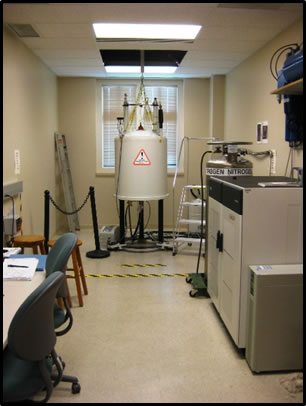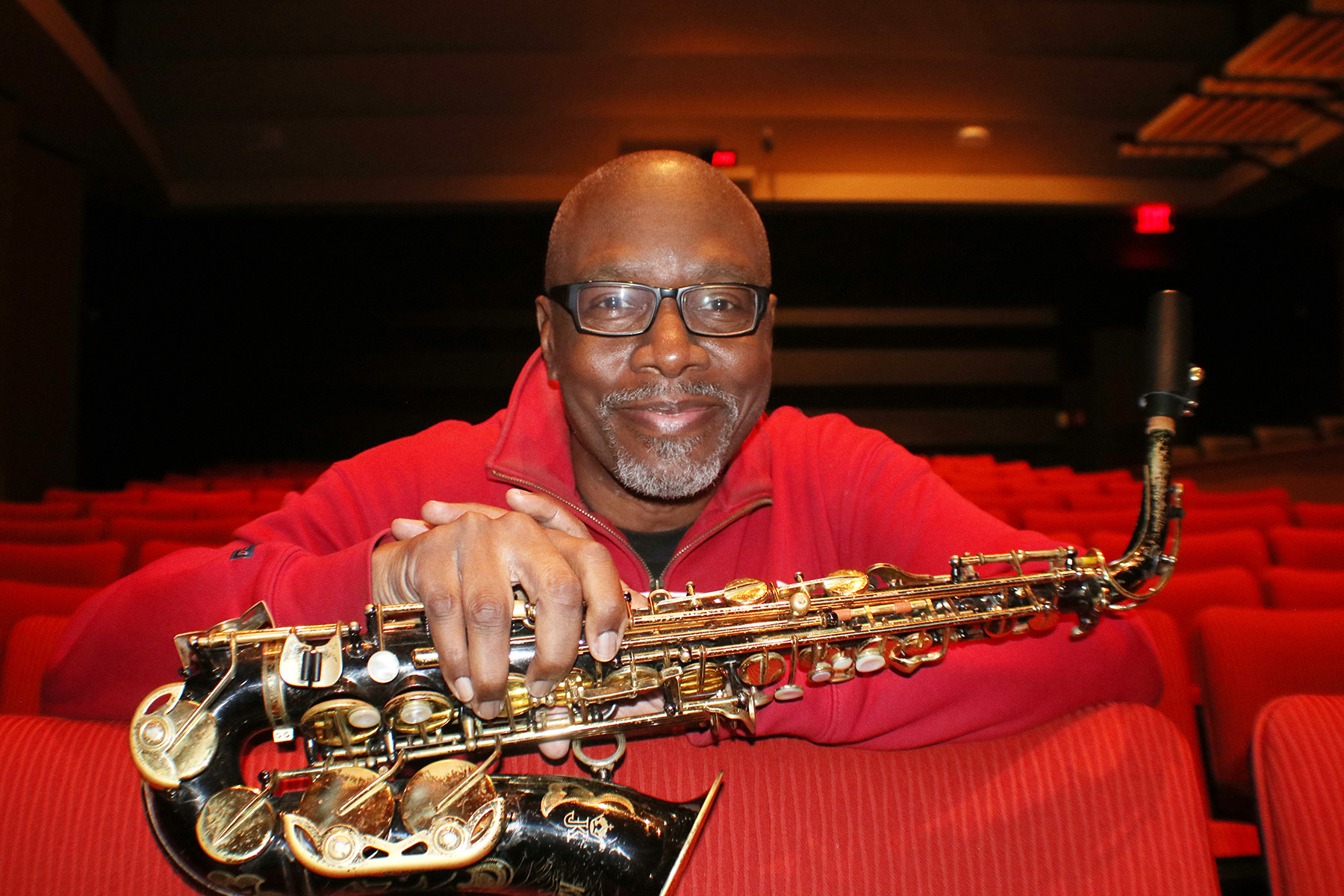
Environmental Health and Safety
Nuclear Magnetic Resonance Spectroscopy (NMR)
 All Central Washington University NMR users should read and be familiar with the following safety information. There are multiple potential hazards in the NMR laboratory.
All Central Washington University NMR users should read and be familiar with the following safety information. There are multiple potential hazards in the NMR laboratory.
CWU’s NMR instrument uses a large superconducting magnet that is housed in a cryostat containing liquid helium and liquid nitrogen.
The Chemistry Department has a Bruker Avance 400 MHz NMR Spectrometer located on the second floor, SW corner of the Science Building. The room is 10 feet wide and 30 feet deep. The required 10 and 5 gauss lines are marked on the floor. The unit is positioned at the far end (of the entrance) and center of the room (west end).
Just for information's sake, the surrounding walls to the north, south, and east are of 18-gauge aluminum stud walls with 2-hour fire-resistant gypsum board construction. The north wall is of double-thickness construction. The wall to the west is the exterior wall with brick veneer and concrete/rebar. The floor is concrete and rebar. Above the NMR room is an open space (outside); to the north is a research computer laboratory; to the south is a research laboratory; to the east is the hallway; and below is a conference room.
Magnetic Field Hazards
Magnets will exert large attractive forces on equipment or other magnetic objects when brought close. The force may become large enough to move the equipment uncontrollably toward the NMR magnet. Small pieces of metallic subjects (wrenches, screwdrivers, etc.) may become projectiles. Large equipment (gas cylinders) can cause bodies or limbs to become trapped between the equipment and the magnet. Keep in mind the following:
- The closer to the magnet, the larger the force.
- The larger the mass, the larger the force.
- Remember: Superconducting magnets are ALWAYS on.
You can watch this video of a demonstration of what happens when you get a heavy iron object too close to a magnet.
Rules:
- Do bring any metallic object within 10 feet of any magnet. Assume all metallic objects are ferromagnetic and will be attracted to the magnets unless verified by NMR staff.
- Do NOT bring compressed gas cylinders into the NMR laboratories without NMR personnel supervision.
- NEVER put any object into the magnet, except the NMR tube and holder.
- For low-temperature NMR experiments, use the non-magnetic nitrogen dewar that is available. Do not use a wrench to disconnect the quick connector on the dewar. Keep the Thermo immersion cooler (which is slightly magnetic) at least 5 feet from the magnet.
Medical Implants
The operation of electronic, electrical or mechanical medical implants, such as cardiac pacemakers, biostimulators, and neurostimulators may be affected or even stopped in the presence of either static or changing magnetic fields. Medical implants such as aneurysm clips, surgical clips, or prostheses may contain ferromagnetic materials and therefore would be subjected to strong attractive forces near the magnet. This could result in injury or death. Additionally, in the vicinity of rapidly changing fields (pulsed gradient fields), eddy currents may be induced in the implant resulting in heat generation.
Rules:
- Persons with these types of implants MUST remain outside the NMR laboratory until more extensive safety training is provided by NMR staff.
Cryogen Hazards
Cryogens such as liquid nitrogen (LN2) and liquid helium that are present in the magnet cryostat and portable dewars may pose several dangers, including asphyxiation, frostbite, and chemical explosions.
- When a magnet quenches, or suddenly becomes non-superconducting, large amounts of liquid cryogens are quickly vaporized. Due to their large expansion ratios (nitrogen 695:1, helium 760:1), these gases can quickly displace all the oxygen in the NMR room and cause asphyxiation. Effects from oxygen deficiency become noticeable at levels below ~18% and sudden death may occur at ~6% oxygen content by volume.
- Direct contact with cryogenic substances in liquid or vapor form can produce “cold burns” on the skin similar to conventional burns. The temperature of liquid helium is -2690 C and of liquid nitrogen is -1960 C.
- Cryogenic fluids with a boiling point below that of liquid oxygen are able to condense oxygen from the atmosphere. Repeated replenishment of the system can thereby cause oxygen to accumulate. Violent reactions, e.g. rapid combustion or explosion, may occur if the materials, which make contact with the oxygen, are combustible.
Rules:
- If you observe a sudden exhaust of gas from a magnet (and NMR staff are not performing a cryogen fill) or if the oxygen sensor alarm sounds, EXIT the NMR laboratory IMMEDIATELY.
- NMR staff periodically must replenish the magnet’s cryogens. During a fill, keep away from the gaseous exhaust from the magnet as frostbite burns may result.
- When handling cryogens, wear gloves, goggles, and closed-toe shoes.
- When doing low-temperature NMR work and using the LN2 dewar, beware of liquid splashing and rapid flash off of LN2 when immersing the variable-temperature NMR apparatus into the dewar. This operation must be carried out very slowly.
- Always replace the loose-fitting cap onto the LN2 dewar to avoid the condensation of oxygen in the dewar.
NMR Sample Tube Saftey
NMR sample tubes have thin walls and are easily broken. Once broken, they are extremely sharp. When inserting an NMR sample tube into the spinner, grap the tube close to the spinner. This will avoid applying a torque that can easily break a tube and, often, drive it into a finger.Chemical Safety- Hazardous and Dangerous Materials
All users who conduct experiments with hazardous materials, including toxic and radioactive materials, including pressurized, explosive, or otherwise unusually hazardous materials must closely follow CWU Environmental Health and Safety guidelines. Failure to do so may jeopardize the environment and safety of all users and may lead to suspension of facility access privilege and payment of any cleanup cost.Rules:
- When using NMR sample tubes filled with highly toxic and dangerous materials, such as mercury, thallium, etc, please transport NMR sample tubes in appropriate safety containers, not simply in a flask or other open container, or carried by hand.
- NMR sample tubes are often broken in the NMR. Please clean up non-hazardous spills and broken glass. For toxic or hazardous materials, do not attempt to clean up yourself. Instead, inform NMR staff who will perform the clean-up work. The clean-up may require shutting down the system and some disassembly. If toxic or hazardous materials are involved, please contact CWU Environmental Health and Safety (509) 963-2252 (8 am -5 pm weekdays).
Users of the NMR need to be aware that the spectrometers have magnets which are always at field. Large attractive forces are therefore exerted on magnetic materials which are brought in close proximity to the magnets. The magnetic field drops off rapidly with distance from the spectrometer and an important measurement is the distance from the center of the magnet to the 5 gauss (5G) line, which is the cut-off point for most safety issues and can be regarded as a safe operating distance. The 5G line is clearly indicated around each spectrometer by a black and yellow strip on the floor.

In Case of Emergency:
If an emergency, dial 911 from any campus phone. If the situation is not an emergency, you may call 509-963-3000 for campus assistance. It is your responsibility to report any accident to the NMR technical personnel immediately.
CWU News

Online Master’s of Education program now offers special education endorsement
May 15, 2024
by Rune Torgersen

Lenny Price brings Detroit perspective to CWU Jazz
May 15, 2024
by University Relations